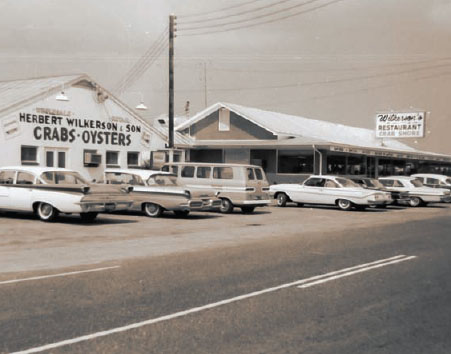
A NAME SYNONYMOUS WITH SEAFOOD:
The Wilkersons

Anyone driving into Colonial Beach on the two-lane road into town knows Wilkerson’s. Perched on a narrow spit of land that backs up to the Potomac River, it’s been a landmark restaurant for decades. Before the nearby Harry Nice Bridge was built connecting Maryland and Virginia on Route 301, a primary north-south highway, ferryboats brought passengers, cars and even cattle to docks just beside the restaurant.
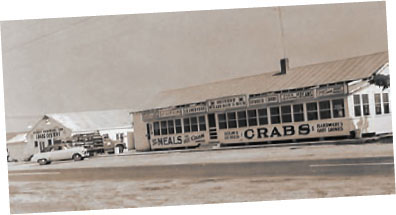
Though that tiny stretch of road in front of the restaurant is referred to as Potomac Beach, it’s now considered part of the town of Colonial Beach.
What newcomers may not know and what a few old-timers remember well is that way back there were two Wilkerson restaurants, maybe one hundred yards apart, competing for customers on their way into town.
“The family has been in the seafood business for a long time,” Jimmy Wilkerson, owner of the existing restaurant, recalls. “My great-grandfather, Stephen Wilkerson, started the first restaurant in the early 1930s.”
It was a natural fit to complement the local seafood industry that most men in the area with the last name of Wilkerson worked in.
Stephen had four sons—William E., Herbert, Butch and Albert—and all had a hand in the restaurant in one way or another, whether it was catching the seafood or helping to run the day-to-day operations.
“When Dad [Walter, Herbert’s son] came home after World War II ended, it was already crowded, and there was no room for him in the restaurant,” Jimmy says. “So in 1946, Herbert and Walter purchased land down the street and started a second restaurant, where Herbert and his wife, Florence, and Walter and his wife, Catherine, all worked together to get the new business going.”
There was no business connection between the two restaurants, despite the family ties and their proximity.
Tensions mounted when Walter applied for a liquor license and his uncle fought it. “There was right much friction at the time,” Jimmy says. “They all had right much of a temper.”
Friction or not, the two restaurants coexisted for years. Walter’s sister, Ellen, later began working in the family business. Walter and Catherine’s son, Jimmy, grew up working in and learning the business, as well.
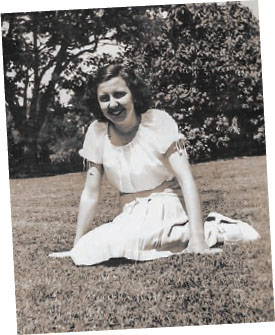
Ellen Wilkerson
Jimmy went away to school to the Fork Union Military Academy during his high school years, then attended college in North Carolina. When he came back in 1970, Jimmy was ready to follow in his father’s footsteps by continuing to operate the restaurant and staying in the seafood business.
Jimmy remembers growing up when Colonial Beach was “a robust little town.” His father and Denny Conner, one of the brothers who brought casinos and a lot of entertainment to the boardwalk, were close friends. He’d go down to the boardwalk as a child to ride the amusement park rides.
His father had a business strategy that took into account people’s gambling habits. Because of the restaurant’s location, he liked to catch their attention when they drove into town. “He tried to get them when they were coming in, when he could sell them seafood dinners. On the way out, they were more likely to buy hamburgers,” Jimmy says.
After Stephen passed away, the first Wilkerson’s restaurant was then run by his son, William E., and later was passed on to his children, Louis, Helen and Stephen. Soon after that transition, Louis came to work for Herbert and Walter after a falling out. When the first location closed in the late ’70s, Helen and Stephen joined Louis in working at the current location, as well. Helen, who died in May 2017, was a beloved waitress there for many years.

The Happy Clam after Hurricane Isabel
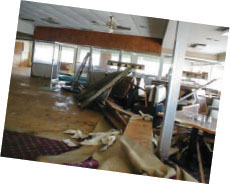
Wilkerson’s dining room after Hurricane Isabel
The original restaurant was later reopened as The Happy Clam, which operated for a number of years, but was destroyed by Hurricane Isabel when it hit Colonial Beach in the fall of 2003. It was not rebuilt, though it did operate for a time at another location in town.
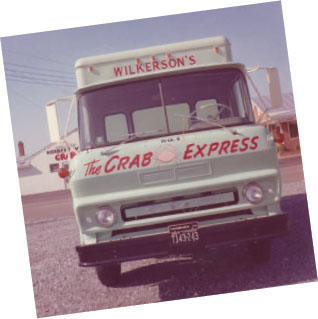
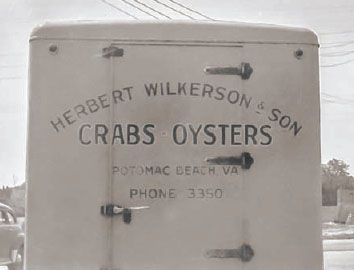
The current Wilkerson’s was severely damaged by that September storm as well, but Jimmy had workers on the job almost immediately after, assessing the damage. He reopened the following spring. Wilkerson’s is qualified now as the longest continuously running restaurant business in town, celebrating its seventieth anniversary in 2016.
From the late 1940s through the 1970s, Herbert Wilkerson & Sons Inc. had a thriving wholesale seafood business distributing green crabs, oysters in the shell, oysters shucked and packed on the premises, crabmeat, fresh and pasteurized on the premises, and fish caught locally throughout the region. Their trucks ran six days a week and had delivery routes from Baltimore, Maryland, to Washington, DC, to Richmond, Virginia, and even had routes into the Shenandoah Valley.
“At one time we’d sell 150 to 200 bushels of crabs wholesale every week, and we had more than forty daily shuckers when the oyster business was booming. Our oysters went up and down the East Coast from New Jersey to Georgia. In the summers I drove the delivery routes, but I didn’t like driving all that much,” Jimmy says.

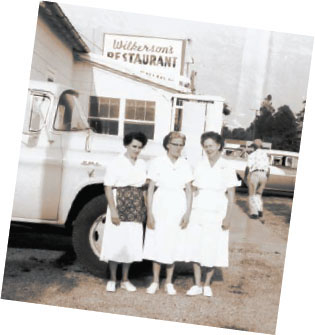

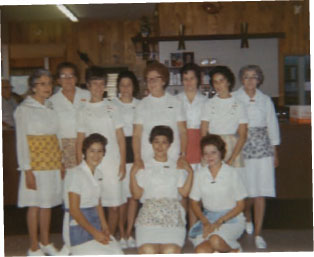
The staff of Wilkerson’s over the years…

Herbert and Walter were among the first to pasteurize crabmeat, and also grew cultured oysters indoors at one time during the 1970s. The high cost of labor for shucking put an end to the oysters for distribution, and the scarcity of crabs ended the packing of crabmeat for sale sometime later. However, they still serve steamed crabs in season and continue to plant and harvest oysters, which are sold to a local shucker and packer. Some of those oysters come back to be served in the restaurant. Jimmy and his son, Jay, catch the majority of the rockfish they serve in the restaurant in the Potomac River.
Over the years the restaurant was updated and expanded to add a second dining room to meet capacity demands. Their signature seafood combinations and all-you-can-eat seafood buffet are legendary in the area. Each Thanksgiving, they offer a popular Thanksgiving–style buffet for those who choose to forego cooking and cleaning up. After Thanksgiving, they close for the remainder of the year and open again for business at the end of January.
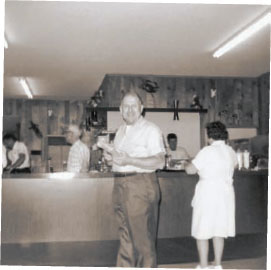
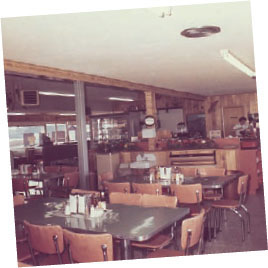

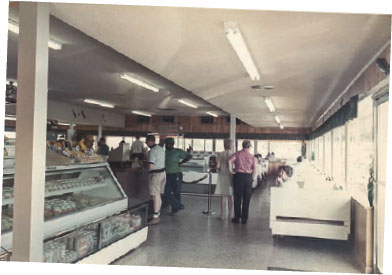
Jimmy’s son, Jay, worked in the restaurant growing up. After studying computers in college, he worked for a few years after graduation at nearby Dahlgren. “I always knew I would be coming back here someday,” Jay says. He has been working alongside his father in the family business for more than ten years now, continuing the family tradition.
While much of their focus is on the restaurant and seafood, they also spend a lot of time on their farming operation, which took on a more prominent role after the wholesale distribution business’s decline. Soon after Jimmy returned home from college, he spearheaded the beginning of that operation starting with just seventy acres. That has grown significantly over the years and is now approaching four thousand acres, though that acreage has fluctuated recently.
“There’s a whole lot of concrete being planted these days,” Jimmy says with obvious regret. Good farmland available to work is hard to find.
One of the things both Jimmy and Jay love about their business is that while it’s a family operation, those who’ve worked there for years become part of the family, too. One current employee has been with the restaurant thirty-nine years, and another recently retired after first picking up trash around the restaurant when his mother brought him to work with her when he was just thirteen.
“We also hire a lot of kids for summer jobs,” Jay says. “They start out washing dishes and busing tables just like I did, and move up from there. Once they get on here, most of them don’t want to leave and stay on for the duration of their high school years, some even longer.”
They have all learned to work quickly to keep the tables turning over and the lines of customers moving. Jay’s son, Derek, is already learning to bus tables and help out where he can, the same way Jay started out.
What Jimmy finds most gratifying is seeing people who come back to Colonial Beach over the years and have a lot of memories tied to this unique little beach town. He smiles when he adds, “It’s nice that this restaurant is one of them.”

